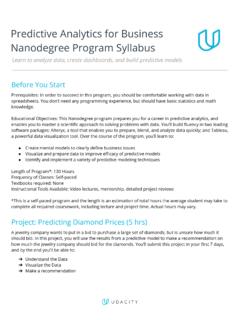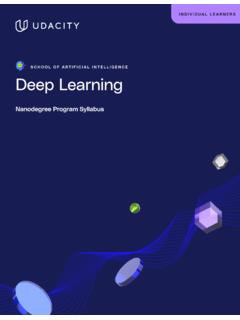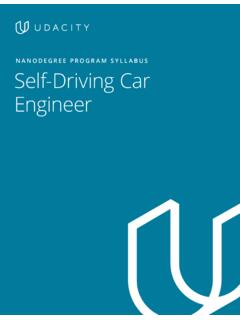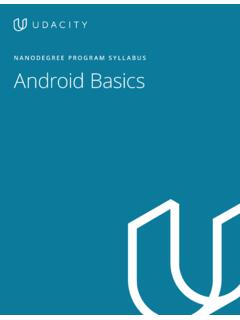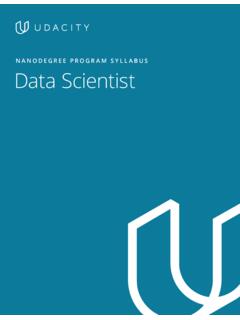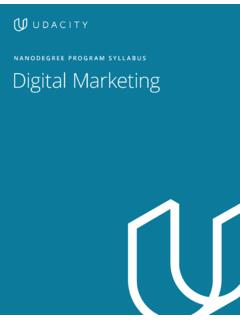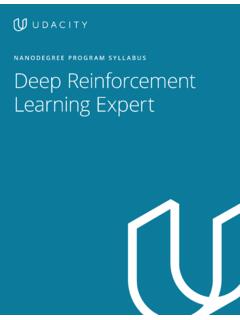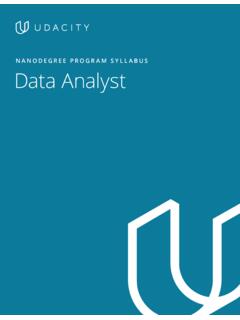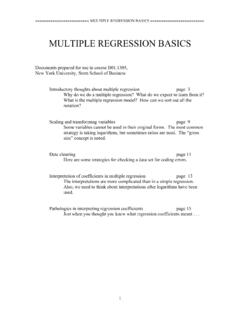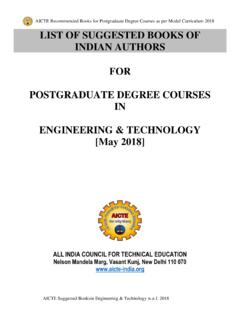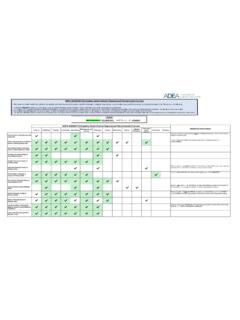Transcription of Programming for Data Science with Python Nanodegree ...
1 Need Help? Speak with an Advisor: for data Science with PythonNANODEGREE PROGRAM SYLLABUSP rogramming for data Science with Python | 2 Need Help? Speak with an Advisor: the Programming fundamentals required for a career in data Science . By the end of the program, you will be able to use Python , SQL, Command Line, and : No Experience RequiredFlexible Learning: Self-paced, so you can learn on the schedule that works best for youEstimated Time: 3 Months at 10hrs/weekNeed Help? Discuss this program with an enrollment COLLABORATION WITHP rogramming for data Science with Python | 3 Need Help? Speak with an Advisor: 1: Introduction to SQLL earn SQL fundamentals such as JOINs, Aggregations, and Subqueries. Learn how to use SQL to answer complex business OUTCOMESLESSON ONEB asic SQL Write common SQL commands including SELECT, FROM, and WHERE Use logical operators like LIKE, AND, and ORLESSON TWOSQL Joins Write JOINs in SQL, as you are now able to combine data from multiple sources to answer more complex business questions Understand different types of JOINs and when to use each typeLESSON THREESQL Aggregations Write common aggregations in SQL including COUNT, SUM, MIN, and MAX Write CASE and DATE functions, as well as work with NULLsLESSON FOURA dvanced SQL Queries Use subqueries, also called CTEs, in a number of different situations Use other window functions including RANK, NTILE, LAG, LEAD new functions along with partitions to complete complex tasksCourse Project Investigate a DatabaseIn this project, you ll work with a relational database while working with PostgreSQL.
2 You ll complete the entire data analysis process, starting by posing a question, running appropriate SQL queries to answer your questions and finishing by sharing your for data Science with Python | 4 Need Help? Speak with an Advisor: 2: Introduction to Python ProgrammingIn this part, you ll learn to represent and store data using Python data types and variables, and use conditionals and loops to control the flow of your programs. You ll harness the power of complex data structures like lists, sets, dictionaries, and tuples to store collections of related data . You ll define and document your own custom functions, write scripts, and handle errors. You will also learn to use two powerful Python libraries - Numpy, a scientific computing package, and Pandas, a data manipulation OUTCOMESLESSON ONEWhy Python Programming Gain an overview of what you ll be learning and doing in the course Understand why you should learn Programming with PythonLESSON TWOData Types and Operators Represent data using Python s data types: integers, floats, booleans, strings, lists, tuples, sets, dictionaries, compound data structures Perform computations and create logical statements using Python s operators: Arithmetic, Assignment, Comparison, Logical, Membership, Identity Declare, assign, and reassign values using Python variables Modify values using built-in functions and methods Practice whitespace and style guidelinesCourse Project Explore US Bikeshare DataYou will use Python to answer interesting questions about bikeshare trip data collected from three US cities.
3 You will write code to collect the data , compute descriptive statistics , and create an interactive experience in the terminal that presents the answers to your for data Science with Python | 5 Need Help? Speak with an Advisor: THREEC ontrol FLow Write conditional expressions using if statements and boolean expressions to add decision making to your Python programs Use for and while loops along with useful built-in functions to iterate over and manipulate lists, sets, and dictionaries Skip iterations in loops using break and continue Condense for loops to create lists efficiently with list comprehensionsLESSON FOURF unctions Define your own custom functions Create and reference variables using the appropriate scope Add documentation to functions using docstrings Define lambda expressions to quickly create anonymous functions Use iterators and generators to create streams of dataLESSON FIVES cripting Install Python 3 and set up your Programming environment Run and edit Python scripts Interact with raw input from users Identify and handle errors and exceptions in your code Open, read.
4 And write to files Find and use modules in Python Standard Library and third-party libraries Experiment in the terminal using a Python InterpreterLESSON SIXN umpy Create, access, modify, and sort multidimensional NumPy arrays (ndarrays) Load and save ndarrays Use slicing, boolean indexing, and set operations to select or change subsets of an ndarray Understand difference between a view and a copy of ndarray Perform element-wise operations on ndarrays Use broadcasting to perform operations on ndarrays of different SEVENP andas Create, access, and modify the main objects in Pandas, Series and DataFrames Perform arithmetic operations on Series and DataFrames Load data into a DataFrame Deal with Not a Number (NaN) valuesProgramming for data Science with Python | 6 Need Help? Speak with an Advisor: 3: Introduction to Version ControlLearn how to use version control and share your work with other people in the data Science OUTCOMESLESSON ONES hell Workshop The Unix shell is a powerful tool for developers of all sorts.
5 Get a quick introduction to the basics of using it on your TWOP urpose & Terminology Learn why developers use version control and discover ways you use version control in your daily life Get an overview of essential Git vocabulary Configure Git using the command lineLESSON THREEC reate a Git Repo Create your first Git repository with git init Copy an existing Git repository with git clone Review the current state of a repository with the powerful git statusLESSON FOURR eview a Repo s History Review a repo s commit history git log Customize git log s output using command line flags in order to reveal more (or less) information about each commit Use the git show command to display just one commit Course Project Post your work on GithubIn this project, you will learn important tools that all programmers use. First, you ll get an introduction to working in the terminal. Next, you ll learn to use git and Github to manage versions of a program and collaborate with others on Programming projects.
6 In this projectyou will post two different versions of a Jupyter Notebook capturing your learnings from the course, and add commits to your project Git for data Science with Python | 7 Need Help? Speak with an Advisor: FIVEAdd Commits to a Repo Master the Git workflow and make commits to an example project Use git diff to identify what parts of a file have been changed in a commit Learn how to mark files as untracked using .gitignoreLESSON SIXT agging, Branching, and Merging Tagging, Branching, and Merging Organize your commits with tags and branches Jump to particular tags and branches using git checkout Learn how to merge together changes on different branches and crush those pesky merge conflictsLESSON SEVENU ndoing Changes Learn how and when to edit or delete an existing commit Use git commit s -amend flag to alter the last commit Use git reset and git revert to undo and erase commitsProgramming for data Science with Python | 8 Need Help?
7 Speak with an Advisor: Classroom ExperienceREAL-WORLD PROJECTSB uild your skills through industry-relevant projects. Get personalized feedback from our network of 900+ project reviewers. Our simple interface makes it easy to submit your projects as often as you need and receive unlimited feedback on your answers to your questions with Knowledge, ourproprietary wiki. Search questions asked by other students,connect with technical mentors, and discover in real-timehow to solve the challenges that you encounter. WORKSPACESSee your code in action. Check the output and quality of your code by running them on workspaces that are a part of our your understanding of concepts learned in the program by answering simple and auto-graded quizzes. Easily go back to the lessons to brush up on concepts anytime you get an answer STUDY PLANSC reate a custom study plan to suit your personal needs and use this plan to keep track of your progress toward your TRACKERStay on track to complete your Nanodegree program with useful milestone for data Science with Python | 9 Need Help?
8 Speak with an Advisor: with the BestDerek SteerCEO AT MODED erek is the CEO of Mode Analytics. He developed an analytical foundation at Facebook and Yammer and is passionate about sharing it with future analysts. He authored SQL School and is a mentor at Insight data Lee CURRICULUM LEADJuno is the curriculum lead for the School of data Science . She has been sharing her passion for data and teaching, building several courses at Udacity. As a data scientist, she built recommendation engines, computer vision and NLP models, and tools to analyze user KalehoffINSTRUCTORR ichard is a Course Developer with a passion for teaching. He has a degree in computer Science , and first worked for a nonprofit doing everything from front end web development, to backend Programming , to database and server BernhardDATA SCIENTISTJosh has been sharing his passion for data for nearly a decade at all levels of university, and as Lead data Science Instructor at Galvanize.
9 He s used data Science for work ranging from cancer research to process for data Science with Python | 10 Need Help? Speak with an Advisor: with the BestKarl Krueger INSTRUCTORB efore joining Udacity, Karl was a Site Reliability Engineer (SRE) at Google for eight years, building automation and monitoring to keep the world s busiest web services for data Science with Python | 11 Need Help? Speak with an Advisor: Our Nanodegree Programs Include:EXPERIENCED PROJECT REVIEWERSREVIEWER SERVICES Personalized feedback & line by line code reviews 1600+ Reviewers with a average rating 3 hour average project review turnaround time Unlimited submissions and feedback loops Practical tips and industry best practices Additional suggested resources to improveTECHNICAL MENTOR SUPPORTMENTORSHIP SERVICES Questions answered quickly by our team of technical mentors 1000+ Mentors with a average rating Support for all your technical questionsPERSONAL CAREER SERVICESCAREER SUPPORT Resume support Github portfolio review LinkedIn profile optimizationProgramming for data Science with Python | 12 Need Help?
10 Speak with an Advisor: Asked QuestionsPROGRAM OVERVIEWWHY SHOULD I ENROLL? The Programming for data Science with Python Nanodegree program offers you the opportunity to learn the most important Programming languages used by data scientists today. Get your start into the fascinating field of data Science and learn Python , SQL, terminal, and git with the help of experienced instructors. WHAT JOBS WILL THIS PROGRAM PREPARE ME FOR? This is an introductory program that is not designed to prepare you for a specific job. However, as a graduate of this program, you will be proficient in the Programming skills used in many data analysis and data Science roles, including Python , SQL, Terminal, and DO I KNOW IF THIS PROGRAM IS RIGHT FOR ME? If you are interested in taking the first step into the field of data Science , this course is for you. This course will quickly teach you the foundational data Science Programming tools ( Python , SQL, Git).
